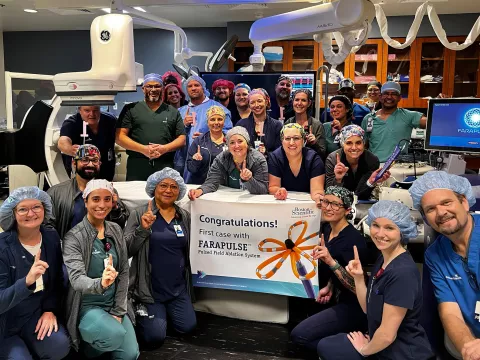- AdventHealth
Collaborative Research Study Published in Transplantation and Cellular Therapy
Sarfraz Ahmad
Rushang D. Patel
Juan Carlos Varela
Shahram Mori
Blood and Marrow Transplant Program
AdventHealth Cancer Institute
James Yu1, Yuan Du2, Sarfraz Ahmad3, Rushang D. Patel4, Juan Carlos Varela4, Chung-Che Chang5, Shahram Mori4
1Department of Internal Medicine, 2Research Institute, 3Gynecologic Oncology Program, 4Blood and Marrow Transplant Center, 5Department of Pathology and Laboratory Medicine, AdventHealth Hospital, AdventHealth Cancer Institute, Orlando, FL 32804
Summary
The ideal conditioning intensity in allogeneic hematopoietic stem cell transplantation (HSCT) is evolving. Previous prospective studies comparing myeloablative conditioning (MAC) versus reduced-intensity conditioning (RIC) regimens in adults with acute myelogenous leukemia (AML) have shown mixed results. In many of these studies, patients were not stratified based on measurable residual disease (MRD).
We evaluated the effect of conditioning intensity on the outcomes of AML patients in complete remission (CR) with flow cytometry evidence of MRD negativity. A total of 135 patients age 20 to 75 years with AML in CR1 or CR2 and flow cytometry evidence of MRD negativity who underwent allogeneic HSCT at our center between 2011 and 2019 were evaluated. We compared overall survival (OS), relapse-free survival (RFS), non-relapse mortality (NRM), relapse, and acute and chronic graft-versus-host disease (GVHD) in recipients of MAC (n=89) and RIC (n=46).
Although the patients receiving RIC were older (62 versus 51 years; p<0.0001), there were no statistically significant differences between the groups in terms of Eastern Cooperative Oncology Group and European Leukemia Network risk criteria and disease status (CR1 or CR2) at the time of transplantation. At a median follow-up of 24.6 months, no statistically significant differences in OS (hazard ratio [HR], 0.78; 95% confidence interval [CI] 0.42 to 1.42, p=0.411) or RFS (HR, 1.004; 95% CI, 0.48 to 2.09, p=0.99) were identified. The cumulative incidence of NRM (HR, 0.595; 95% CI, 0.24 to 1.48; p=0.2644) and relapse (HR, 1.007; 95% CI, 0.45 to 2.23; p=0.9872) was not different between the 2 groups. Grade II-IV and grade III-IV acute GVHD were more frequent in the MAC group (39.3% versus 19.9% [p=0.018] and 19.3% versus 2.3% [p<0.001], respectively), as was moderate/severe chronic GVHD (23.6% versus 15.8%; p=0.038).
Our data indicate that conditioning intensity did not appear to affect OS, RFS, NRM, and relapse risk in patients with MRD-negative AML as measured by flow cytometry. RIC resulted in less severe acute and chronic GVHD.
Highlights
- The ideal conditioning intensity in allogeneic HSCT in patients with MRD negativity is evolving.
- At a median follow-up of 24 months, no significant differences in OS and RFS were noted between patients receiving MAC and those receiving RIC with flow cytometry evidence of MRD negativity.
- The rates of grade III-IV acute GVHD and moderate/severe chronic GVHD were higher in the MAC group compared with the RIC group.
- RIC may be an option in younger patients without evidence of MRD, although further prospective randomized trials with longer follow-up will be needed to confirm our findings.
For more information or to refer a patient, call one of our Bone Marrow Transplant Nurse Navigators: Austin Carroll, BSN, RN; Anna Cullivan, BSN, RN; Vielka Hernandez, RN; or Heather Brown, RN, at Call407-303-2825.
Link to Article: https://www.astctjournal.org/article/S2666-6367(21)00864-2/pdf
Recent News
The AdventHealth Neuroscience Institute is the first in Florida and one of the first in the country to begin recruiting patients with primary progressive or non-active secondary progressive multiple...
Discover what’s being accomplished in Central Florida to bridge the health gap with Orange County Mayor Jerry Demings and AdventHealth’s Dr. Alric Simmonds.
Breakthrough device offers new hope for stroke survivors struggling with rehabilitation following ischemic stroke
The Convergent Hybrid Ablation procedure has been gaining acceptance as an effective treatment option for long-standing persistent atrial fibrillation (AFib) since the CONVERGE trial data published in...
Recently, AdventHealth for Children pediatric orthopedic surgeon Sean Keyes, DO, Katelyn Smith, PA-C, and their team performed their 100th bridge-enhanced anterior cruciate ligament (ACL) repair (BEAR...
AdventHealth recently began piloting a new Genomics Risk Assessment for Cancer and Early Detection (GRACE) program that combines the use of digital mammography, artificial intelligence (AI) technology...
AdventHealth Clinical Research Unit (CRU) Executive Director and Medical Director of Genitourinary Oncology Guru Sonpavde, MD, co-authored an article on the AMBASSADOR Phase III clinical trial results...
AdventHealth Research Institute is currently seeking physicians experiencing exhaustion, irritability, hopelessness, anxiety, work/home imbalance or similar burnout symptoms to participate in a...
A promising new treatment for AFib patients called Pulse Field Ablation is first offered in Central Florida at AdventHealth and shows less damage to tissue.
Plastic and Reconstructive Microsurgeon Sabrina Pavri, MD, and Breast Surgeon Devina McCray, MD, recently began offering immediate neurotization after breast reconstruction, a new surgical technique...
Explore the healing power of music for stroke survivors and their families in this episode of the Inspiring Wholeness podcast.
Dr. Andrew Weinfeld will be responsible for executing clinical and organizational strategy, improving clinical effectiveness and patient safety, and delivering exceptional patient experiences for the...












